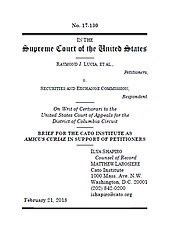Well, Raymond Lucia felt that the Securities and Exchange Commission had such an advantage when he was fined $300,000 and barred from working as an investment adviser after an SEC administrator determined that he had misled prospective clients in a quasi-judicial proceeding that the SEC investigated, prosecuted, and adjudicated without any appreciable oversight.
Lucia fought the SEC, because the agency’s administrative law judges (ALJs) are, in fact, “officers” of the SEC and not mere employees, meaning that under the Constitution’s Appointments Clause, they should have been appointed by and be accountable to the president or a department head. As the Supreme Court held in a similar challenge to the Public Company Accounting Oversight Board in 2010, “if any power whatsoever is in its nature executive, it is the power of appointing, overseeing, and controlling those who execute the laws.” The president has a duty to ensure the law is faithfully executed, and to do so he must be able to remove those officers who fail to uphold their duties.
The U.S. Court of Appeals for the D.C. Circuit deadlocked over the issue of whether ALJs are executive officers and thus subject to the removal power. As it stands, they’re protected from control by the electorate because the president currently lacks the ability to remove ALJs who abuse their powers or otherwise act badly. Cato supported Lucia’s successful petition for Supreme Court review. Now we file on the merits, ahead of oral argument.
The duties of an ALJ are similar to other positions the Court has previously held to be officers, including “special trial judges” and court clerks. If anything, ALJs have more power and discretion than STJs or clerks, and thus it’s critical that they be able to be held accountable.
Both Congress and the SEC have recognized that ALJs are officers. That conclusion borders on the obvious considering how much more closely the ALJ position aligns with historical and legal definitions of an “officer,” despite the fact that the name of the position was changed to include the word “judge.” Indeed, the fact that ALJs play a quasi-judicial role does not change the fact that they aren’t judges in the constitutional sense. After all, the Supreme Court established 90 years ago that presidential accountability still applies to officers with a quasi-judicial function.
The Framers knew how to create an independent judiciary; they successfully did so in Article III of our Constitution. This independence, however, can’t constitutionally be extended to officers in the executive branch, no matter what they call themselves. The ALJ corps is not a junior-varsity team of Article III judges. They are executive officers, period. To effectively extend Article III independence to an Article II officer, regardless of the title attached to the particular positions, would be to create a fourth branch of government (or fifth, or sixth, depending on how one counts various parts of the existing bureaucracy).
The Supreme Court should find ALJs to be “officers of the United States” and thus make them subject to presidential appointment and removal. Oral argument in of Lucia v. SEC hasn’t yet been scheduled, but is expected this April, which would mean a decision by the end of June.


